Ryanair's Competitive Advantage: A VRIO Framework Analysis Report
VerifiedAdded on 2022/08/15
|13
|2916
|36
Report
AI Summary
This report undertakes a VRIO framework analysis of Ryanair, a prominent low-cost airline in Europe. It begins with an executive summary and table of contents, followed by an introduction outlining the report's objectives: to identify Ryanair's distinctive resources and capabilities and to analyze them using the VRIO framework to determine its competitive advantage. The report categorizes Ryanair's resources into tangible (financial) and intangible (human resource, stakeholder relationships, brand name, and technology) assets. A detailed VRIO analysis assesses these resources based on their value, rarity, imitability, and organizational aspects. The report concludes with a critical evaluation of the VRIO framework, including its limitations, and discusses alternative frameworks that could address these limitations. The report is based on the provided case study and annual reports.
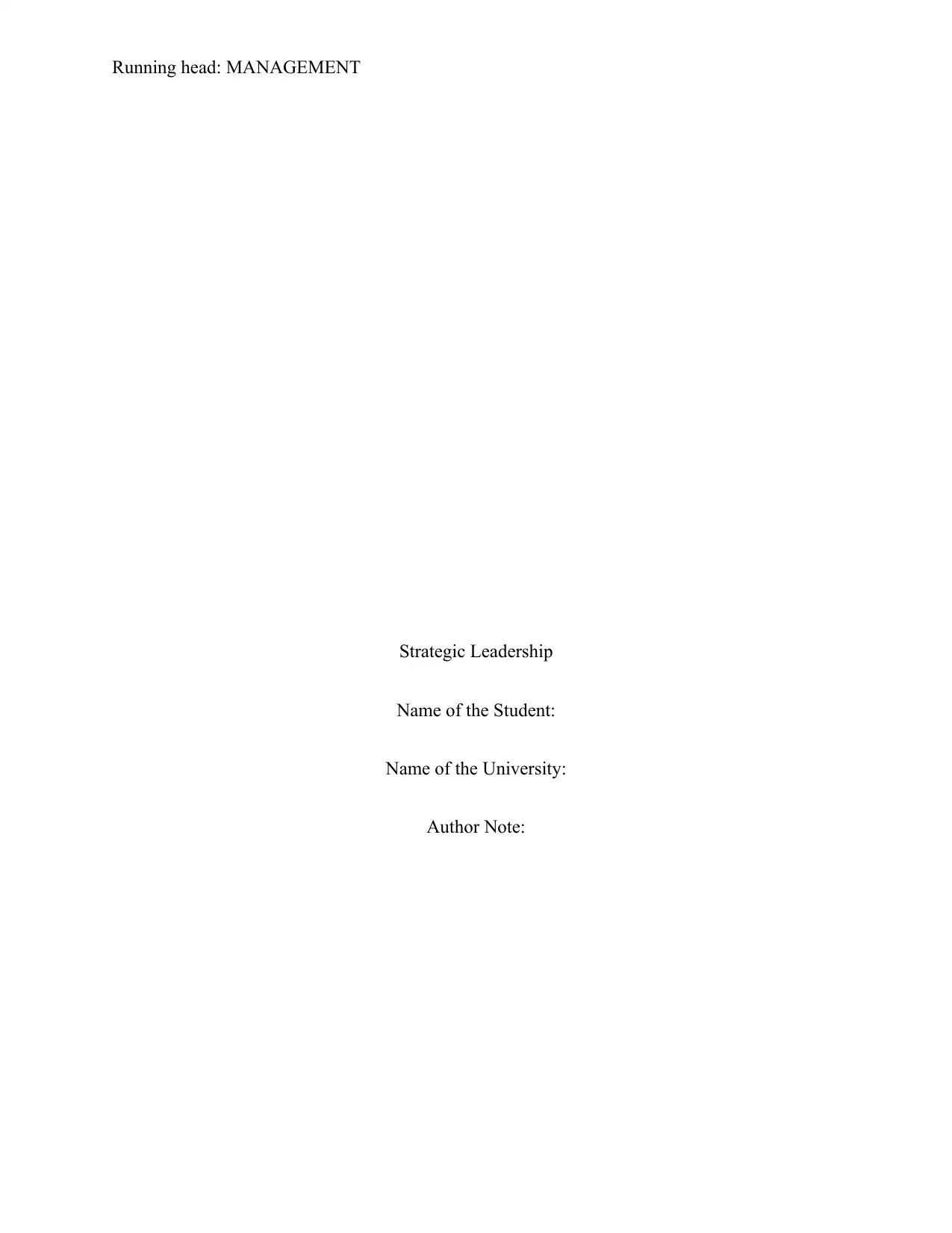
Running head: MANAGEMENT
Strategic Leadership
Name of the Student:
Name of the University:
Author Note:
Strategic Leadership
Name of the Student:
Name of the University:
Author Note:
Paraphrase This Document
Need a fresh take? Get an instant paraphrase of this document with our AI Paraphraser
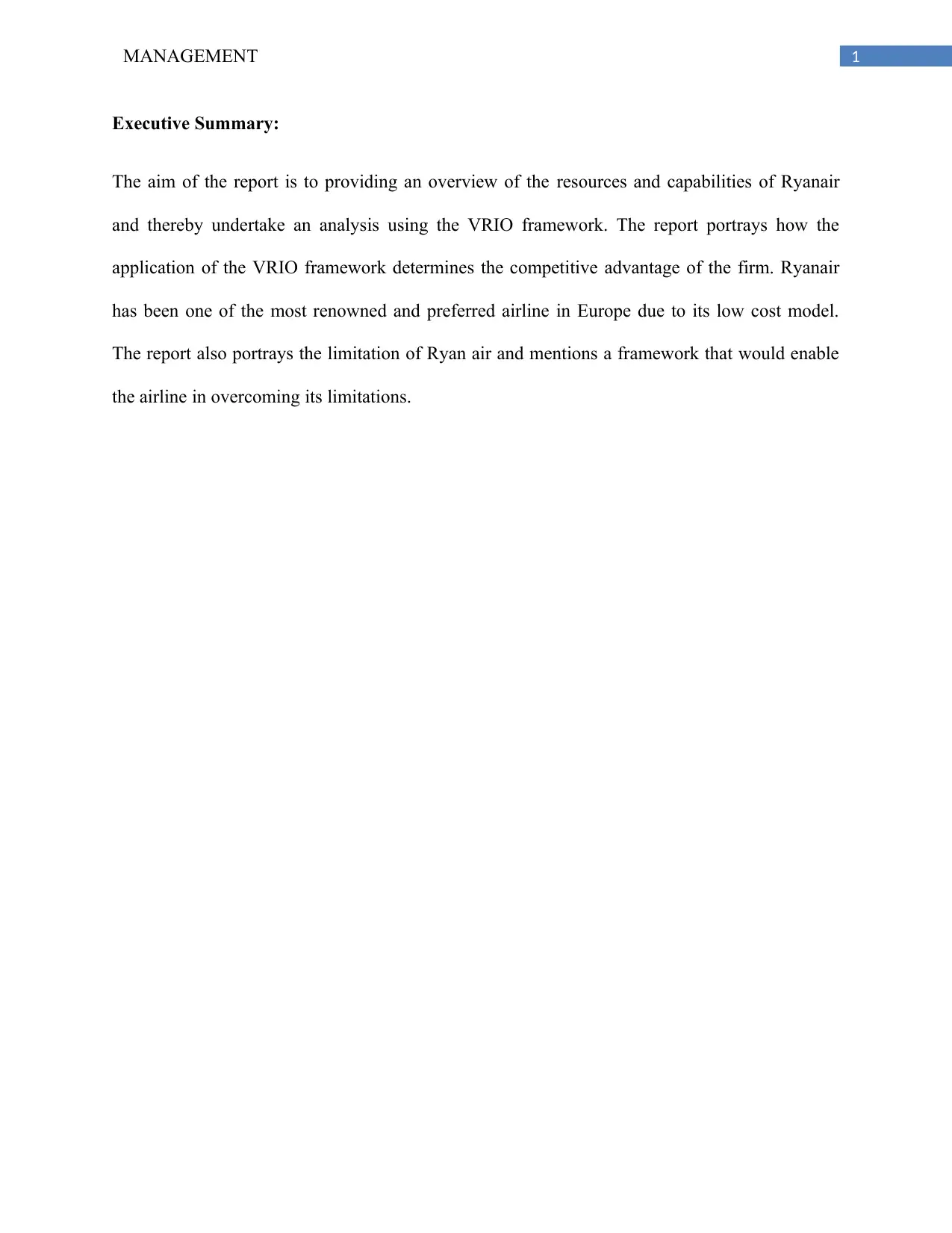
MANAGEMENT 1
Executive Summary:
The aim of the report is to providing an overview of the resources and capabilities of Ryanair
and thereby undertake an analysis using the VRIO framework. The report portrays how the
application of the VRIO framework determines the competitive advantage of the firm. Ryanair
has been one of the most renowned and preferred airline in Europe due to its low cost model.
The report also portrays the limitation of Ryan air and mentions a framework that would enable
the airline in overcoming its limitations.
Executive Summary:
The aim of the report is to providing an overview of the resources and capabilities of Ryanair
and thereby undertake an analysis using the VRIO framework. The report portrays how the
application of the VRIO framework determines the competitive advantage of the firm. Ryanair
has been one of the most renowned and preferred airline in Europe due to its low cost model.
The report also portrays the limitation of Ryan air and mentions a framework that would enable
the airline in overcoming its limitations.
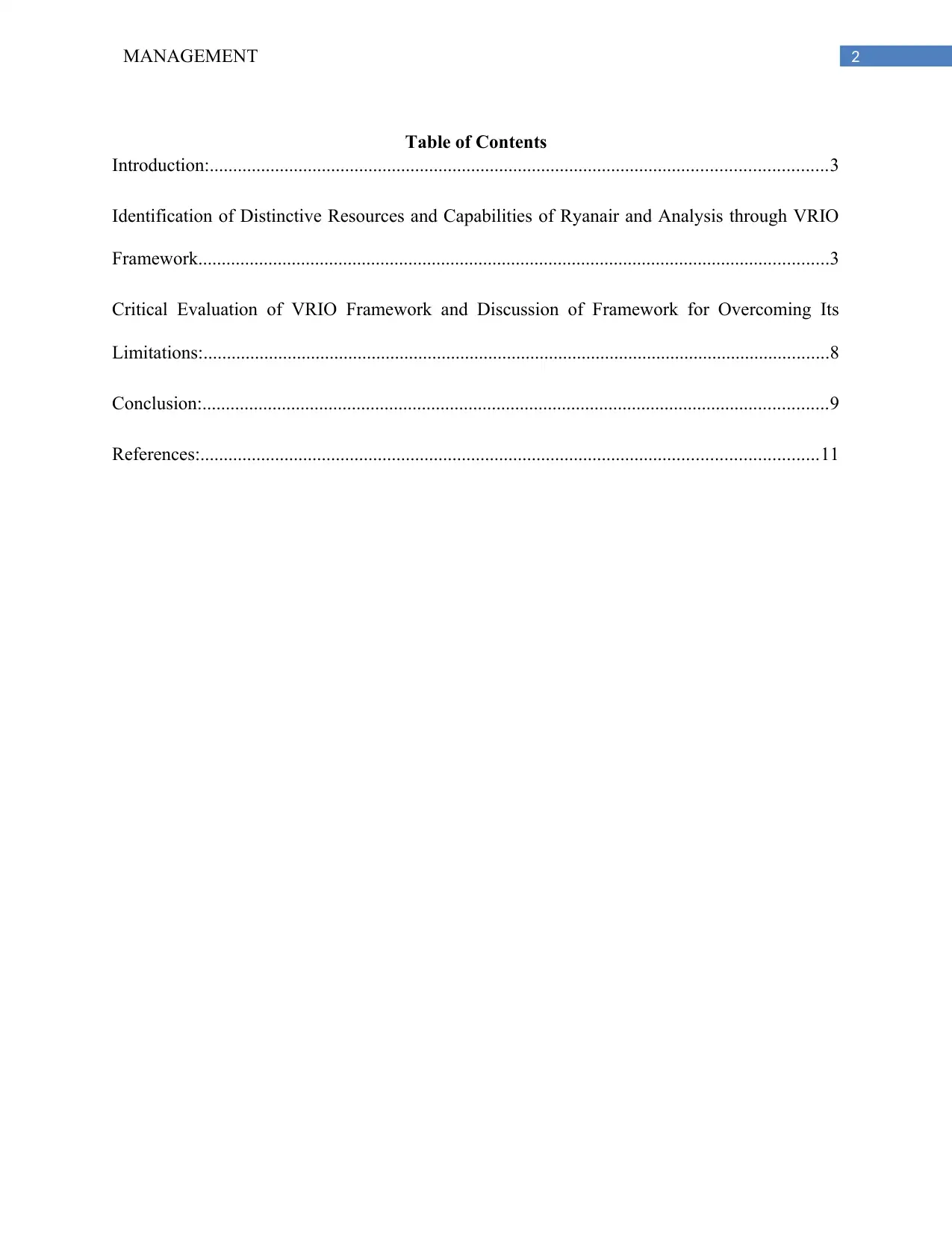
2MANAGEMENT
Table of Contents
Introduction:....................................................................................................................................3
Identification of Distinctive Resources and Capabilities of Ryanair and Analysis through VRIO
Framework.......................................................................................................................................3
Critical Evaluation of VRIO Framework and Discussion of Framework for Overcoming Its
Limitations:......................................................................................................................................8
Conclusion:......................................................................................................................................9
References:....................................................................................................................................11
Table of Contents
Introduction:....................................................................................................................................3
Identification of Distinctive Resources and Capabilities of Ryanair and Analysis through VRIO
Framework.......................................................................................................................................3
Critical Evaluation of VRIO Framework and Discussion of Framework for Overcoming Its
Limitations:......................................................................................................................................8
Conclusion:......................................................................................................................................9
References:....................................................................................................................................11
⊘ This is a preview!⊘
Do you want full access?
Subscribe today to unlock all pages.

Trusted by 1+ million students worldwide
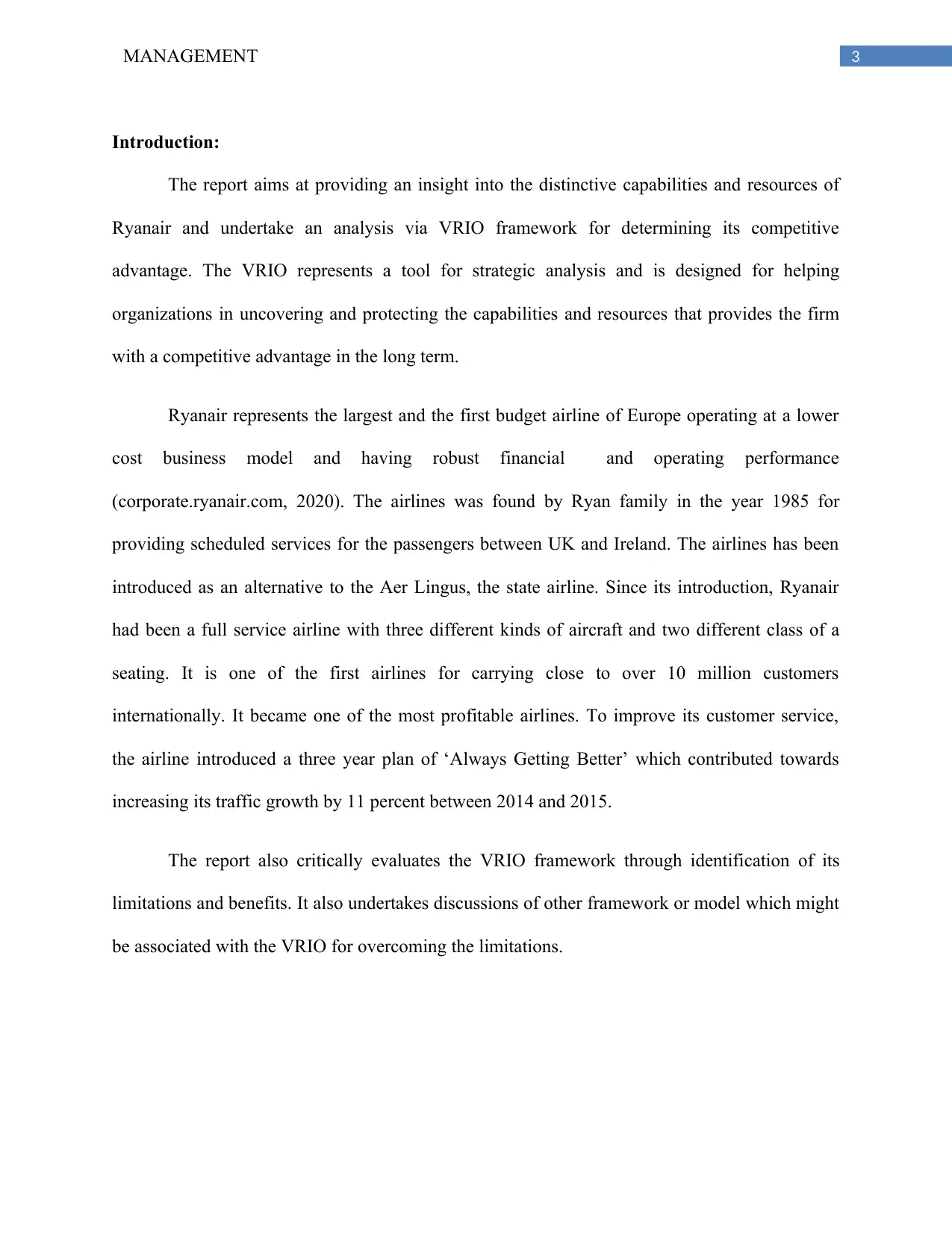
3MANAGEMENT
Introduction:
The report aims at providing an insight into the distinctive capabilities and resources of
Ryanair and undertake an analysis via VRIO framework for determining its competitive
advantage. The VRIO represents a tool for strategic analysis and is designed for helping
organizations in uncovering and protecting the capabilities and resources that provides the firm
with a competitive advantage in the long term.
Ryanair represents the largest and the first budget airline of Europe operating at a lower
cost business model and having robust financial and operating performance
(corporate.ryanair.com, 2020). The airlines was found by Ryan family in the year 1985 for
providing scheduled services for the passengers between UK and Ireland. The airlines has been
introduced as an alternative to the Aer Lingus, the state airline. Since its introduction, Ryanair
had been a full service airline with three different kinds of aircraft and two different class of a
seating. It is one of the first airlines for carrying close to over 10 million customers
internationally. It became one of the most profitable airlines. To improve its customer service,
the airline introduced a three year plan of ‘Always Getting Better’ which contributed towards
increasing its traffic growth by 11 percent between 2014 and 2015.
The report also critically evaluates the VRIO framework through identification of its
limitations and benefits. It also undertakes discussions of other framework or model which might
be associated with the VRIO for overcoming the limitations.
Introduction:
The report aims at providing an insight into the distinctive capabilities and resources of
Ryanair and undertake an analysis via VRIO framework for determining its competitive
advantage. The VRIO represents a tool for strategic analysis and is designed for helping
organizations in uncovering and protecting the capabilities and resources that provides the firm
with a competitive advantage in the long term.
Ryanair represents the largest and the first budget airline of Europe operating at a lower
cost business model and having robust financial and operating performance
(corporate.ryanair.com, 2020). The airlines was found by Ryan family in the year 1985 for
providing scheduled services for the passengers between UK and Ireland. The airlines has been
introduced as an alternative to the Aer Lingus, the state airline. Since its introduction, Ryanair
had been a full service airline with three different kinds of aircraft and two different class of a
seating. It is one of the first airlines for carrying close to over 10 million customers
internationally. It became one of the most profitable airlines. To improve its customer service,
the airline introduced a three year plan of ‘Always Getting Better’ which contributed towards
increasing its traffic growth by 11 percent between 2014 and 2015.
The report also critically evaluates the VRIO framework through identification of its
limitations and benefits. It also undertakes discussions of other framework or model which might
be associated with the VRIO for overcoming the limitations.
Paraphrase This Document
Need a fresh take? Get an instant paraphrase of this document with our AI Paraphraser
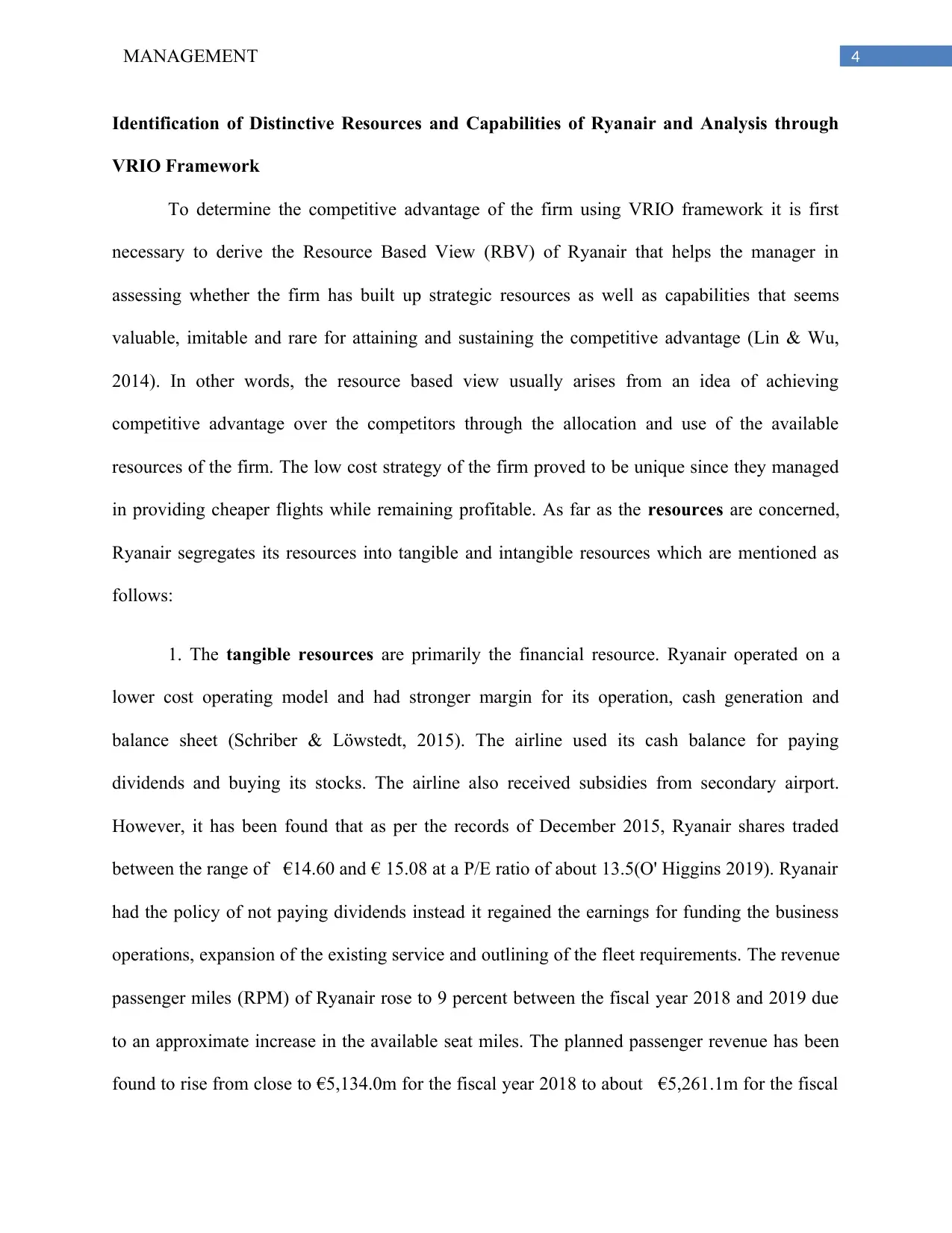
4MANAGEMENT
Identification of Distinctive Resources and Capabilities of Ryanair and Analysis through
VRIO Framework
To determine the competitive advantage of the firm using VRIO framework it is first
necessary to derive the Resource Based View (RBV) of Ryanair that helps the manager in
assessing whether the firm has built up strategic resources as well as capabilities that seems
valuable, imitable and rare for attaining and sustaining the competitive advantage (Lin & Wu,
2014). In other words, the resource based view usually arises from an idea of achieving
competitive advantage over the competitors through the allocation and use of the available
resources of the firm. The low cost strategy of the firm proved to be unique since they managed
in providing cheaper flights while remaining profitable. As far as the resources are concerned,
Ryanair segregates its resources into tangible and intangible resources which are mentioned as
follows:
1. The tangible resources are primarily the financial resource. Ryanair operated on a
lower cost operating model and had stronger margin for its operation, cash generation and
balance sheet (Schriber & Löwstedt, 2015). The airline used its cash balance for paying
dividends and buying its stocks. The airline also received subsidies from secondary airport.
However, it has been found that as per the records of December 2015, Ryanair shares traded
between the range of €14.60 and € 15.08 at a P/E ratio of about 13.5(O' Higgins 2019). Ryanair
had the policy of not paying dividends instead it regained the earnings for funding the business
operations, expansion of the existing service and outlining of the fleet requirements. The revenue
passenger miles (RPM) of Ryanair rose to 9 percent between the fiscal year 2018 and 2019 due
to an approximate increase in the available seat miles. The planned passenger revenue has been
found to rise from close to €5,134.0m for the fiscal year 2018 to about €5,261.1m for the fiscal
Identification of Distinctive Resources and Capabilities of Ryanair and Analysis through
VRIO Framework
To determine the competitive advantage of the firm using VRIO framework it is first
necessary to derive the Resource Based View (RBV) of Ryanair that helps the manager in
assessing whether the firm has built up strategic resources as well as capabilities that seems
valuable, imitable and rare for attaining and sustaining the competitive advantage (Lin & Wu,
2014). In other words, the resource based view usually arises from an idea of achieving
competitive advantage over the competitors through the allocation and use of the available
resources of the firm. The low cost strategy of the firm proved to be unique since they managed
in providing cheaper flights while remaining profitable. As far as the resources are concerned,
Ryanair segregates its resources into tangible and intangible resources which are mentioned as
follows:
1. The tangible resources are primarily the financial resource. Ryanair operated on a
lower cost operating model and had stronger margin for its operation, cash generation and
balance sheet (Schriber & Löwstedt, 2015). The airline used its cash balance for paying
dividends and buying its stocks. The airline also received subsidies from secondary airport.
However, it has been found that as per the records of December 2015, Ryanair shares traded
between the range of €14.60 and € 15.08 at a P/E ratio of about 13.5(O' Higgins 2019). Ryanair
had the policy of not paying dividends instead it regained the earnings for funding the business
operations, expansion of the existing service and outlining of the fleet requirements. The revenue
passenger miles (RPM) of Ryanair rose to 9 percent between the fiscal year 2018 and 2019 due
to an approximate increase in the available seat miles. The planned passenger revenue has been
found to rise from close to €5,134.0m for the fiscal year 2018 to about €5,261.1m for the fiscal
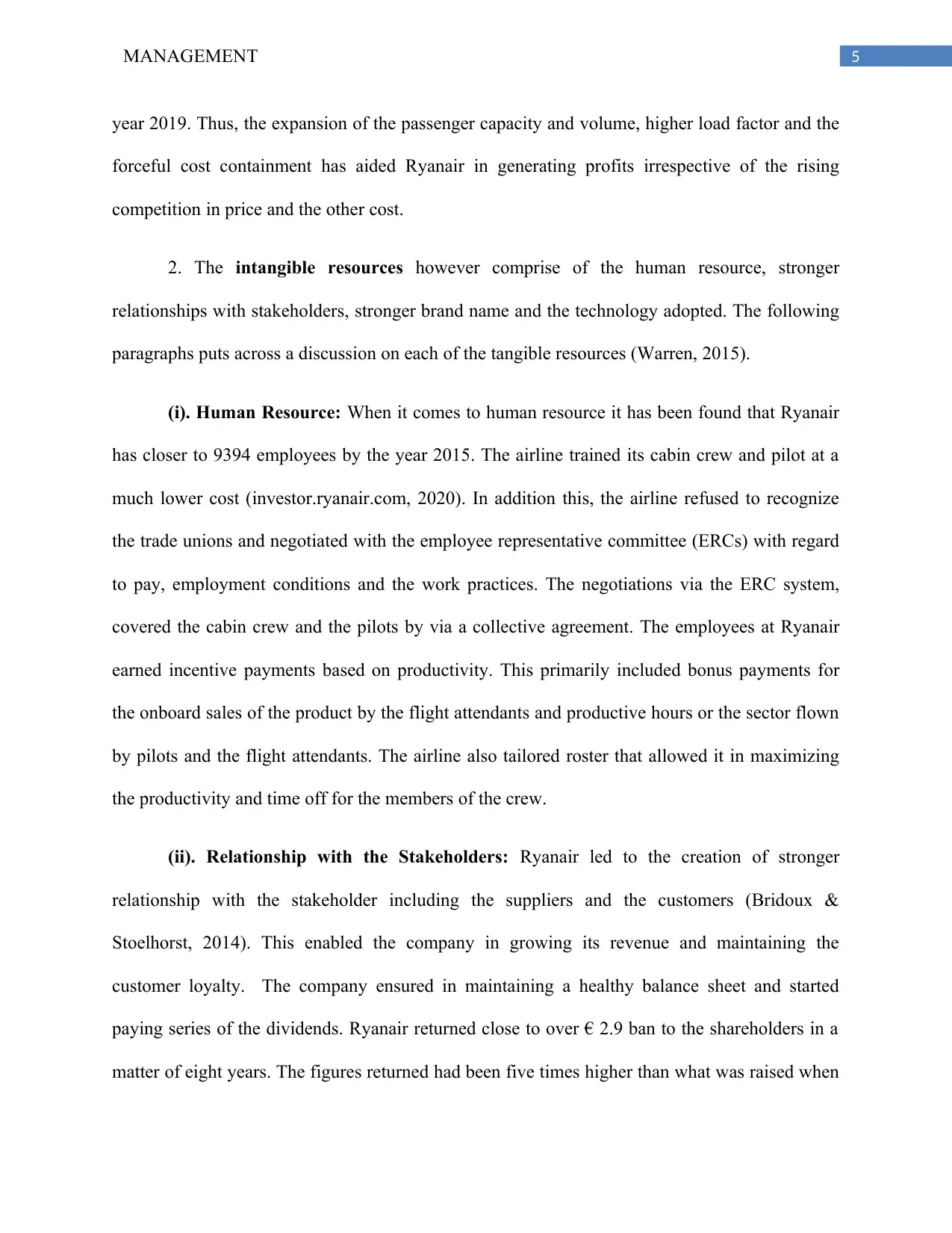
5MANAGEMENT
year 2019. Thus, the expansion of the passenger capacity and volume, higher load factor and the
forceful cost containment has aided Ryanair in generating profits irrespective of the rising
competition in price and the other cost.
2. The intangible resources however comprise of the human resource, stronger
relationships with stakeholders, stronger brand name and the technology adopted. The following
paragraphs puts across a discussion on each of the tangible resources (Warren, 2015).
(i). Human Resource: When it comes to human resource it has been found that Ryanair
has closer to 9394 employees by the year 2015. The airline trained its cabin crew and pilot at a
much lower cost (investor.ryanair.com, 2020). In addition this, the airline refused to recognize
the trade unions and negotiated with the employee representative committee (ERCs) with regard
to pay, employment conditions and the work practices. The negotiations via the ERC system,
covered the cabin crew and the pilots by via a collective agreement. The employees at Ryanair
earned incentive payments based on productivity. This primarily included bonus payments for
the onboard sales of the product by the flight attendants and productive hours or the sector flown
by pilots and the flight attendants. The airline also tailored roster that allowed it in maximizing
the productivity and time off for the members of the crew.
(ii). Relationship with the Stakeholders: Ryanair led to the creation of stronger
relationship with the stakeholder including the suppliers and the customers (Bridoux &
Stoelhorst, 2014). This enabled the company in growing its revenue and maintaining the
customer loyalty. The company ensured in maintaining a healthy balance sheet and started
paying series of the dividends. Ryanair returned close to over € 2.9 ban to the shareholders in a
matter of eight years. The figures returned had been five times higher than what was raised when
year 2019. Thus, the expansion of the passenger capacity and volume, higher load factor and the
forceful cost containment has aided Ryanair in generating profits irrespective of the rising
competition in price and the other cost.
2. The intangible resources however comprise of the human resource, stronger
relationships with stakeholders, stronger brand name and the technology adopted. The following
paragraphs puts across a discussion on each of the tangible resources (Warren, 2015).
(i). Human Resource: When it comes to human resource it has been found that Ryanair
has closer to 9394 employees by the year 2015. The airline trained its cabin crew and pilot at a
much lower cost (investor.ryanair.com, 2020). In addition this, the airline refused to recognize
the trade unions and negotiated with the employee representative committee (ERCs) with regard
to pay, employment conditions and the work practices. The negotiations via the ERC system,
covered the cabin crew and the pilots by via a collective agreement. The employees at Ryanair
earned incentive payments based on productivity. This primarily included bonus payments for
the onboard sales of the product by the flight attendants and productive hours or the sector flown
by pilots and the flight attendants. The airline also tailored roster that allowed it in maximizing
the productivity and time off for the members of the crew.
(ii). Relationship with the Stakeholders: Ryanair led to the creation of stronger
relationship with the stakeholder including the suppliers and the customers (Bridoux &
Stoelhorst, 2014). This enabled the company in growing its revenue and maintaining the
customer loyalty. The company ensured in maintaining a healthy balance sheet and started
paying series of the dividends. Ryanair returned close to over € 2.9 ban to the shareholders in a
matter of eight years. The figures returned had been five times higher than what was raised when
⊘ This is a preview!⊘
Do you want full access?
Subscribe today to unlock all pages.

Trusted by 1+ million students worldwide
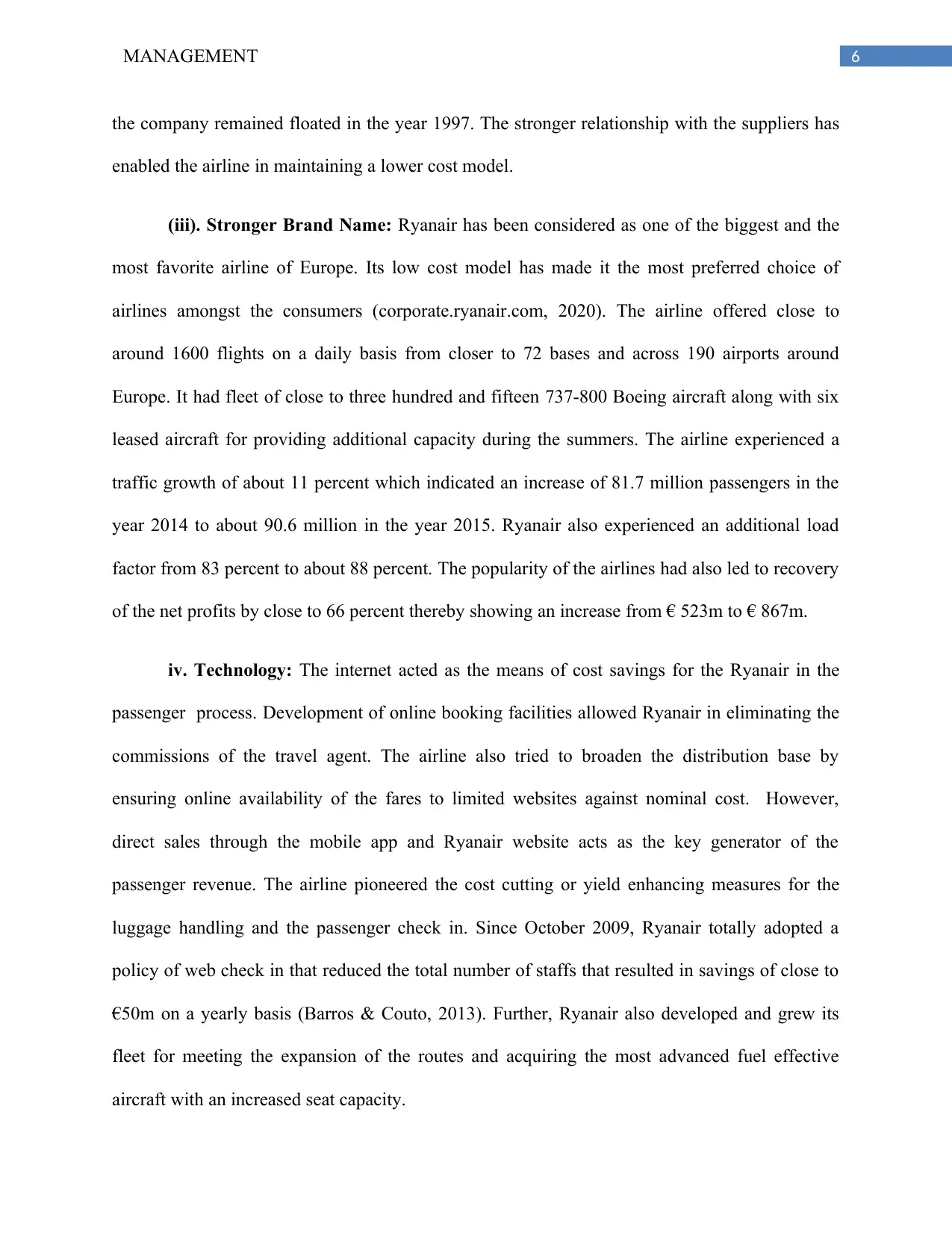
6MANAGEMENT
the company remained floated in the year 1997. The stronger relationship with the suppliers has
enabled the airline in maintaining a lower cost model.
(iii). Stronger Brand Name: Ryanair has been considered as one of the biggest and the
most favorite airline of Europe. Its low cost model has made it the most preferred choice of
airlines amongst the consumers (corporate.ryanair.com, 2020). The airline offered close to
around 1600 flights on a daily basis from closer to 72 bases and across 190 airports around
Europe. It had fleet of close to three hundred and fifteen 737-800 Boeing aircraft along with six
leased aircraft for providing additional capacity during the summers. The airline experienced a
traffic growth of about 11 percent which indicated an increase of 81.7 million passengers in the
year 2014 to about 90.6 million in the year 2015. Ryanair also experienced an additional load
factor from 83 percent to about 88 percent. The popularity of the airlines had also led to recovery
of the net profits by close to 66 percent thereby showing an increase from € 523m to € 867m.
iv. Technology: The internet acted as the means of cost savings for the Ryanair in the
passenger process. Development of online booking facilities allowed Ryanair in eliminating the
commissions of the travel agent. The airline also tried to broaden the distribution base by
ensuring online availability of the fares to limited websites against nominal cost. However,
direct sales through the mobile app and Ryanair website acts as the key generator of the
passenger revenue. The airline pioneered the cost cutting or yield enhancing measures for the
luggage handling and the passenger check in. Since October 2009, Ryanair totally adopted a
policy of web check in that reduced the total number of staffs that resulted in savings of close to
€50m on a yearly basis (Barros & Couto, 2013). Further, Ryanair also developed and grew its
fleet for meeting the expansion of the routes and acquiring the most advanced fuel effective
aircraft with an increased seat capacity.
the company remained floated in the year 1997. The stronger relationship with the suppliers has
enabled the airline in maintaining a lower cost model.
(iii). Stronger Brand Name: Ryanair has been considered as one of the biggest and the
most favorite airline of Europe. Its low cost model has made it the most preferred choice of
airlines amongst the consumers (corporate.ryanair.com, 2020). The airline offered close to
around 1600 flights on a daily basis from closer to 72 bases and across 190 airports around
Europe. It had fleet of close to three hundred and fifteen 737-800 Boeing aircraft along with six
leased aircraft for providing additional capacity during the summers. The airline experienced a
traffic growth of about 11 percent which indicated an increase of 81.7 million passengers in the
year 2014 to about 90.6 million in the year 2015. Ryanair also experienced an additional load
factor from 83 percent to about 88 percent. The popularity of the airlines had also led to recovery
of the net profits by close to 66 percent thereby showing an increase from € 523m to € 867m.
iv. Technology: The internet acted as the means of cost savings for the Ryanair in the
passenger process. Development of online booking facilities allowed Ryanair in eliminating the
commissions of the travel agent. The airline also tried to broaden the distribution base by
ensuring online availability of the fares to limited websites against nominal cost. However,
direct sales through the mobile app and Ryanair website acts as the key generator of the
passenger revenue. The airline pioneered the cost cutting or yield enhancing measures for the
luggage handling and the passenger check in. Since October 2009, Ryanair totally adopted a
policy of web check in that reduced the total number of staffs that resulted in savings of close to
€50m on a yearly basis (Barros & Couto, 2013). Further, Ryanair also developed and grew its
fleet for meeting the expansion of the routes and acquiring the most advanced fuel effective
aircraft with an increased seat capacity.
Paraphrase This Document
Need a fresh take? Get an instant paraphrase of this document with our AI Paraphraser
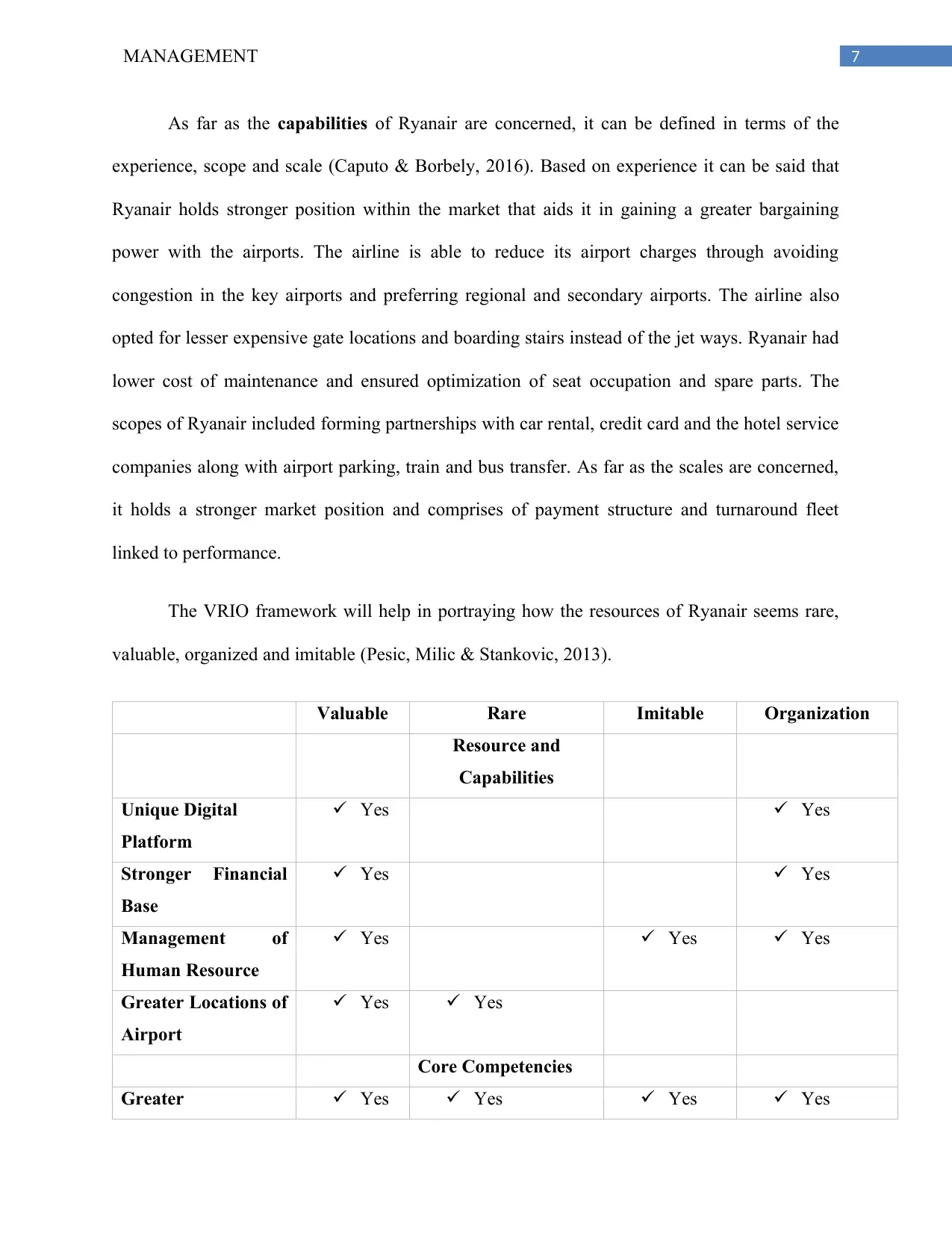
7MANAGEMENT
As far as the capabilities of Ryanair are concerned, it can be defined in terms of the
experience, scope and scale (Caputo & Borbely, 2016). Based on experience it can be said that
Ryanair holds stronger position within the market that aids it in gaining a greater bargaining
power with the airports. The airline is able to reduce its airport charges through avoiding
congestion in the key airports and preferring regional and secondary airports. The airline also
opted for lesser expensive gate locations and boarding stairs instead of the jet ways. Ryanair had
lower cost of maintenance and ensured optimization of seat occupation and spare parts. The
scopes of Ryanair included forming partnerships with car rental, credit card and the hotel service
companies along with airport parking, train and bus transfer. As far as the scales are concerned,
it holds a stronger market position and comprises of payment structure and turnaround fleet
linked to performance.
The VRIO framework will help in portraying how the resources of Ryanair seems rare,
valuable, organized and imitable (Pesic, Milic & Stankovic, 2013).
Valuable Rare Imitable Organization
Resource and
Capabilities
Unique Digital
Platform
Yes Yes
Stronger Financial
Base
Yes Yes
Management of
Human Resource
Yes Yes Yes
Greater Locations of
Airport
Yes Yes
Core Competencies
Greater Yes Yes Yes Yes
As far as the capabilities of Ryanair are concerned, it can be defined in terms of the
experience, scope and scale (Caputo & Borbely, 2016). Based on experience it can be said that
Ryanair holds stronger position within the market that aids it in gaining a greater bargaining
power with the airports. The airline is able to reduce its airport charges through avoiding
congestion in the key airports and preferring regional and secondary airports. The airline also
opted for lesser expensive gate locations and boarding stairs instead of the jet ways. Ryanair had
lower cost of maintenance and ensured optimization of seat occupation and spare parts. The
scopes of Ryanair included forming partnerships with car rental, credit card and the hotel service
companies along with airport parking, train and bus transfer. As far as the scales are concerned,
it holds a stronger market position and comprises of payment structure and turnaround fleet
linked to performance.
The VRIO framework will help in portraying how the resources of Ryanair seems rare,
valuable, organized and imitable (Pesic, Milic & Stankovic, 2013).
Valuable Rare Imitable Organization
Resource and
Capabilities
Unique Digital
Platform
Yes Yes
Stronger Financial
Base
Yes Yes
Management of
Human Resource
Yes Yes Yes
Greater Locations of
Airport
Yes Yes
Core Competencies
Greater Yes Yes Yes Yes
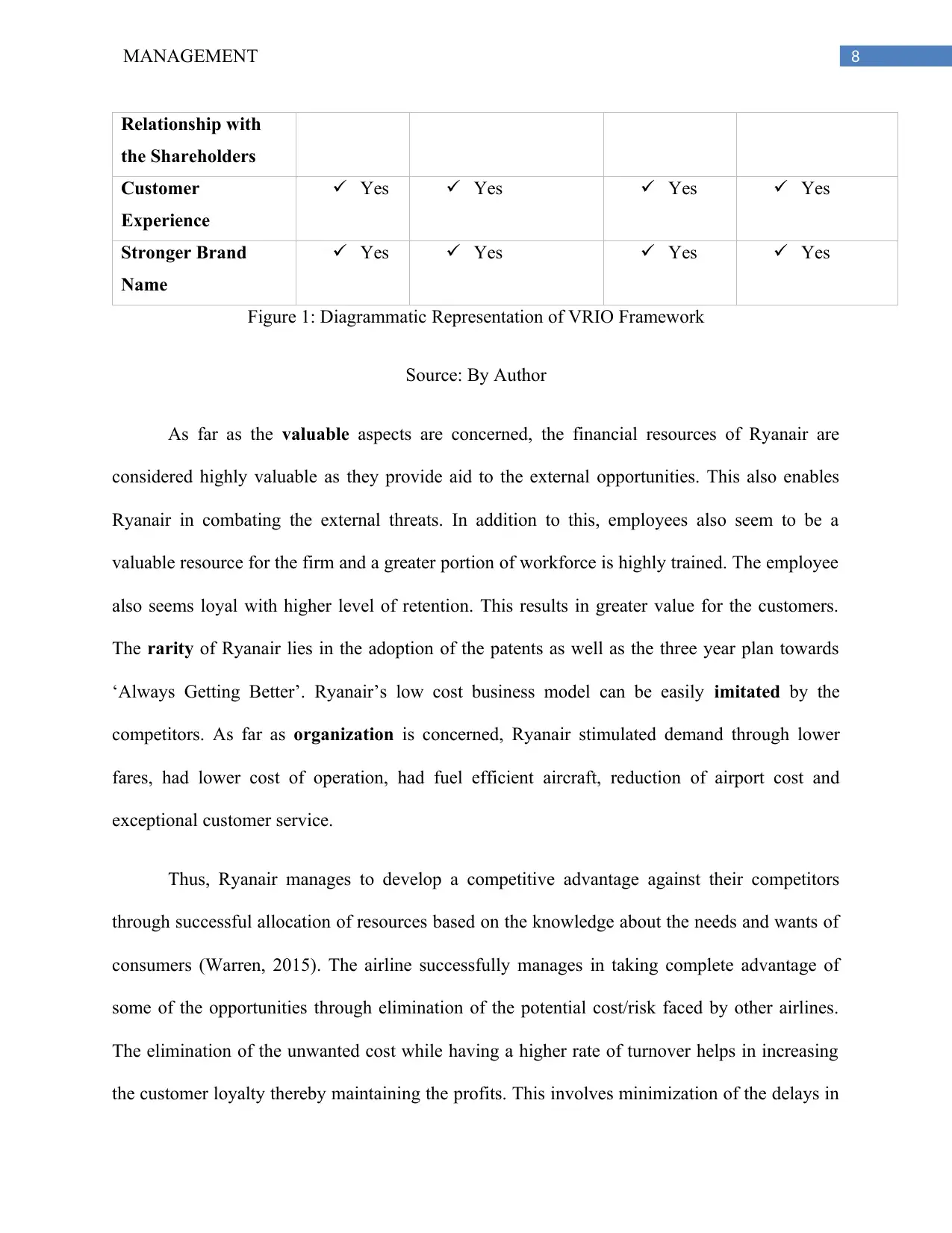
8MANAGEMENT
Relationship with
the Shareholders
Customer
Experience
Yes Yes Yes Yes
Stronger Brand
Name
Yes Yes Yes Yes
Figure 1: Diagrammatic Representation of VRIO Framework
Source: By Author
As far as the valuable aspects are concerned, the financial resources of Ryanair are
considered highly valuable as they provide aid to the external opportunities. This also enables
Ryanair in combating the external threats. In addition to this, employees also seem to be a
valuable resource for the firm and a greater portion of workforce is highly trained. The employee
also seems loyal with higher level of retention. This results in greater value for the customers.
The rarity of Ryanair lies in the adoption of the patents as well as the three year plan towards
‘Always Getting Better’. Ryanair’s low cost business model can be easily imitated by the
competitors. As far as organization is concerned, Ryanair stimulated demand through lower
fares, had lower cost of operation, had fuel efficient aircraft, reduction of airport cost and
exceptional customer service.
Thus, Ryanair manages to develop a competitive advantage against their competitors
through successful allocation of resources based on the knowledge about the needs and wants of
consumers (Warren, 2015). The airline successfully manages in taking complete advantage of
some of the opportunities through elimination of the potential cost/risk faced by other airlines.
The elimination of the unwanted cost while having a higher rate of turnover helps in increasing
the customer loyalty thereby maintaining the profits. This involves minimization of the delays in
Relationship with
the Shareholders
Customer
Experience
Yes Yes Yes Yes
Stronger Brand
Name
Yes Yes Yes Yes
Figure 1: Diagrammatic Representation of VRIO Framework
Source: By Author
As far as the valuable aspects are concerned, the financial resources of Ryanair are
considered highly valuable as they provide aid to the external opportunities. This also enables
Ryanair in combating the external threats. In addition to this, employees also seem to be a
valuable resource for the firm and a greater portion of workforce is highly trained. The employee
also seems loyal with higher level of retention. This results in greater value for the customers.
The rarity of Ryanair lies in the adoption of the patents as well as the three year plan towards
‘Always Getting Better’. Ryanair’s low cost business model can be easily imitated by the
competitors. As far as organization is concerned, Ryanair stimulated demand through lower
fares, had lower cost of operation, had fuel efficient aircraft, reduction of airport cost and
exceptional customer service.
Thus, Ryanair manages to develop a competitive advantage against their competitors
through successful allocation of resources based on the knowledge about the needs and wants of
consumers (Warren, 2015). The airline successfully manages in taking complete advantage of
some of the opportunities through elimination of the potential cost/risk faced by other airlines.
The elimination of the unwanted cost while having a higher rate of turnover helps in increasing
the customer loyalty thereby maintaining the profits. This involves minimization of the delays in
⊘ This is a preview!⊘
Do you want full access?
Subscribe today to unlock all pages.

Trusted by 1+ million students worldwide
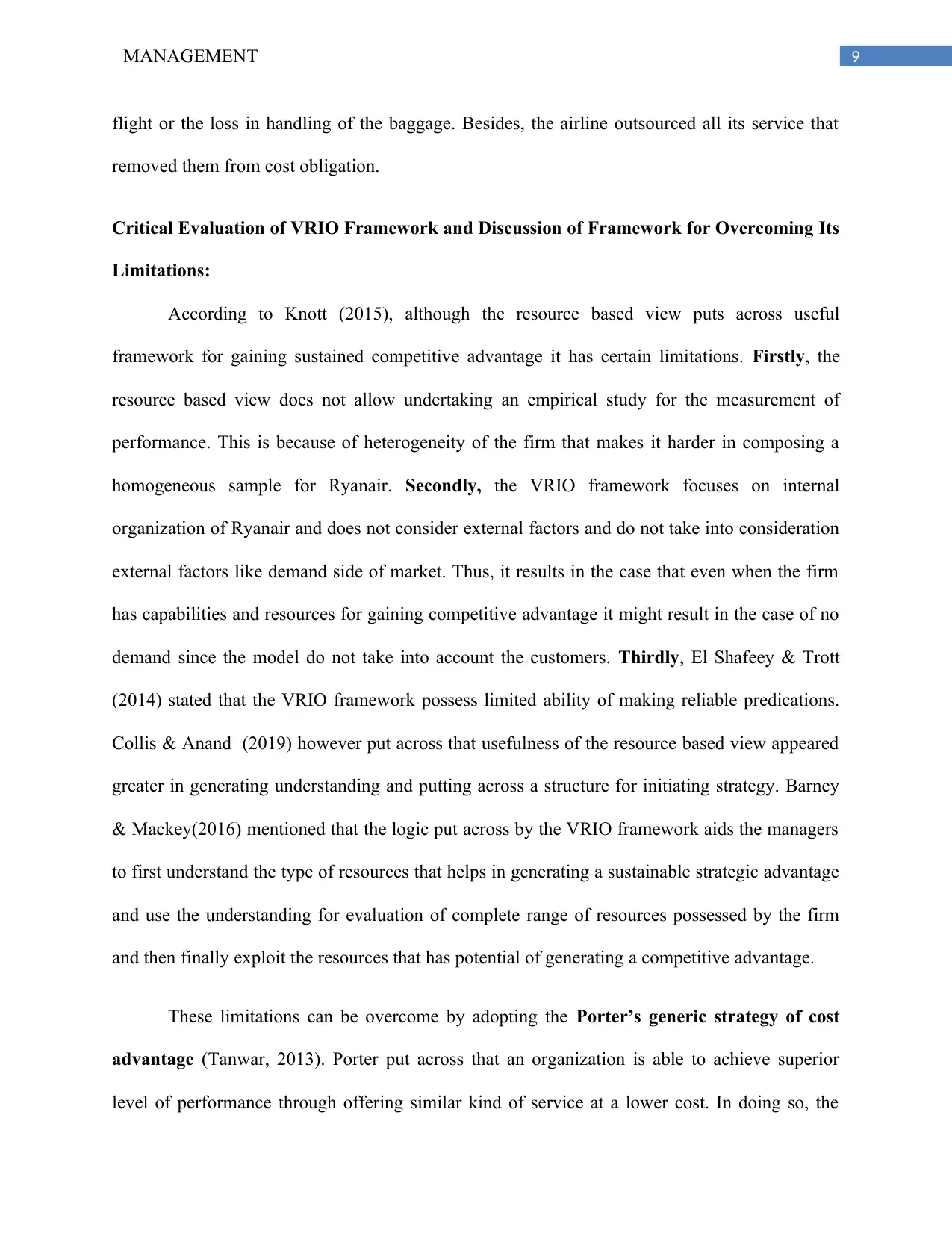
9MANAGEMENT
flight or the loss in handling of the baggage. Besides, the airline outsourced all its service that
removed them from cost obligation.
Critical Evaluation of VRIO Framework and Discussion of Framework for Overcoming Its
Limitations:
According to Knott (2015), although the resource based view puts across useful
framework for gaining sustained competitive advantage it has certain limitations. Firstly, the
resource based view does not allow undertaking an empirical study for the measurement of
performance. This is because of heterogeneity of the firm that makes it harder in composing a
homogeneous sample for Ryanair. Secondly, the VRIO framework focuses on internal
organization of Ryanair and does not consider external factors and do not take into consideration
external factors like demand side of market. Thus, it results in the case that even when the firm
has capabilities and resources for gaining competitive advantage it might result in the case of no
demand since the model do not take into account the customers. Thirdly, El Shafeey & Trott
(2014) stated that the VRIO framework possess limited ability of making reliable predications.
Collis & Anand (2019) however put across that usefulness of the resource based view appeared
greater in generating understanding and putting across a structure for initiating strategy. Barney
& Mackey(2016) mentioned that the logic put across by the VRIO framework aids the managers
to first understand the type of resources that helps in generating a sustainable strategic advantage
and use the understanding for evaluation of complete range of resources possessed by the firm
and then finally exploit the resources that has potential of generating a competitive advantage.
These limitations can be overcome by adopting the Porter’s generic strategy of cost
advantage (Tanwar, 2013). Porter put across that an organization is able to achieve superior
level of performance through offering similar kind of service at a lower cost. In doing so, the
flight or the loss in handling of the baggage. Besides, the airline outsourced all its service that
removed them from cost obligation.
Critical Evaluation of VRIO Framework and Discussion of Framework for Overcoming Its
Limitations:
According to Knott (2015), although the resource based view puts across useful
framework for gaining sustained competitive advantage it has certain limitations. Firstly, the
resource based view does not allow undertaking an empirical study for the measurement of
performance. This is because of heterogeneity of the firm that makes it harder in composing a
homogeneous sample for Ryanair. Secondly, the VRIO framework focuses on internal
organization of Ryanair and does not consider external factors and do not take into consideration
external factors like demand side of market. Thus, it results in the case that even when the firm
has capabilities and resources for gaining competitive advantage it might result in the case of no
demand since the model do not take into account the customers. Thirdly, El Shafeey & Trott
(2014) stated that the VRIO framework possess limited ability of making reliable predications.
Collis & Anand (2019) however put across that usefulness of the resource based view appeared
greater in generating understanding and putting across a structure for initiating strategy. Barney
& Mackey(2016) mentioned that the logic put across by the VRIO framework aids the managers
to first understand the type of resources that helps in generating a sustainable strategic advantage
and use the understanding for evaluation of complete range of resources possessed by the firm
and then finally exploit the resources that has potential of generating a competitive advantage.
These limitations can be overcome by adopting the Porter’s generic strategy of cost
advantage (Tanwar, 2013). Porter put across that an organization is able to achieve superior
level of performance through offering similar kind of service at a lower cost. In doing so, the
Paraphrase This Document
Need a fresh take? Get an instant paraphrase of this document with our AI Paraphraser
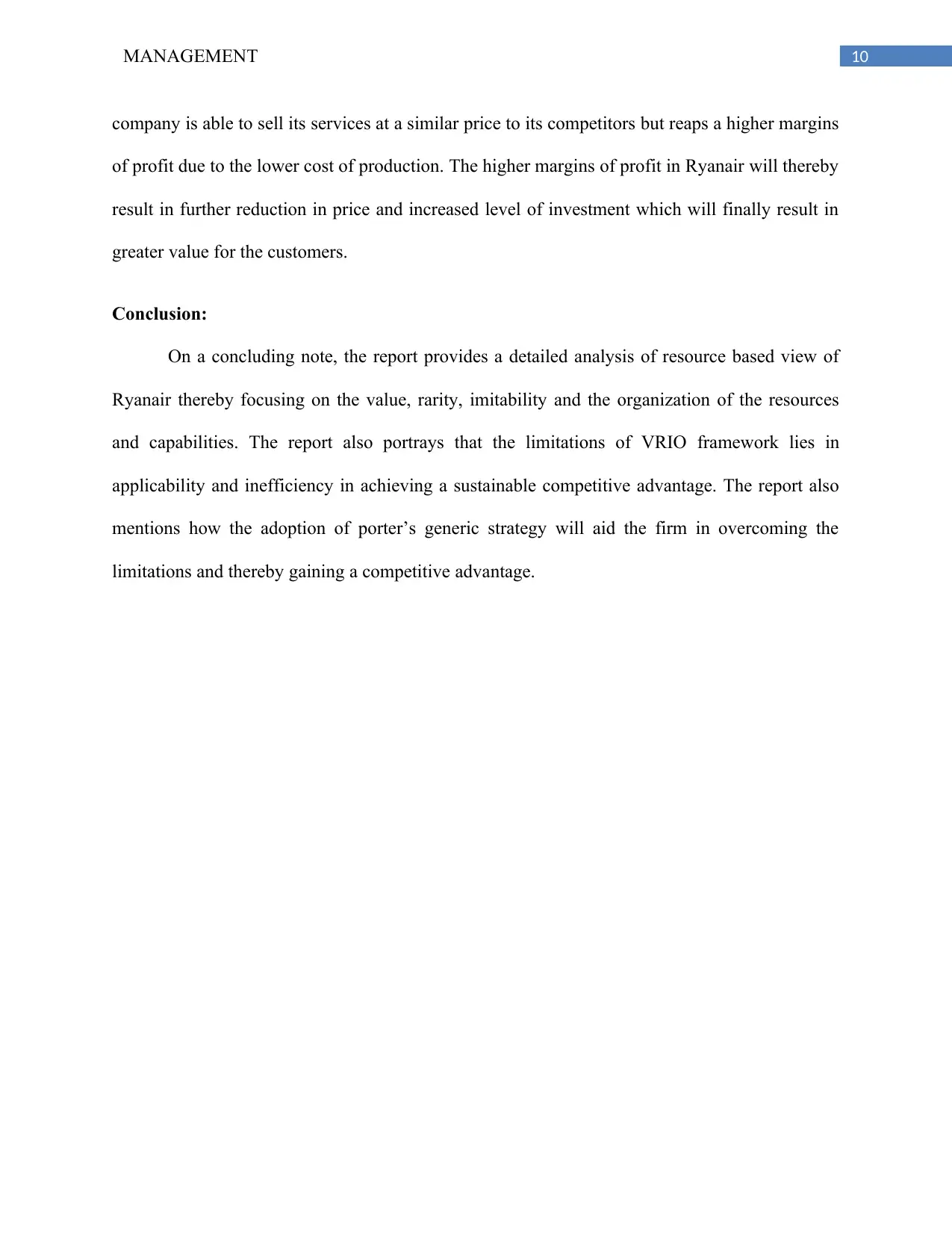
10MANAGEMENT
company is able to sell its services at a similar price to its competitors but reaps a higher margins
of profit due to the lower cost of production. The higher margins of profit in Ryanair will thereby
result in further reduction in price and increased level of investment which will finally result in
greater value for the customers.
Conclusion:
On a concluding note, the report provides a detailed analysis of resource based view of
Ryanair thereby focusing on the value, rarity, imitability and the organization of the resources
and capabilities. The report also portrays that the limitations of VRIO framework lies in
applicability and inefficiency in achieving a sustainable competitive advantage. The report also
mentions how the adoption of porter’s generic strategy will aid the firm in overcoming the
limitations and thereby gaining a competitive advantage.
company is able to sell its services at a similar price to its competitors but reaps a higher margins
of profit due to the lower cost of production. The higher margins of profit in Ryanair will thereby
result in further reduction in price and increased level of investment which will finally result in
greater value for the customers.
Conclusion:
On a concluding note, the report provides a detailed analysis of resource based view of
Ryanair thereby focusing on the value, rarity, imitability and the organization of the resources
and capabilities. The report also portrays that the limitations of VRIO framework lies in
applicability and inefficiency in achieving a sustainable competitive advantage. The report also
mentions how the adoption of porter’s generic strategy will aid the firm in overcoming the
limitations and thereby gaining a competitive advantage.
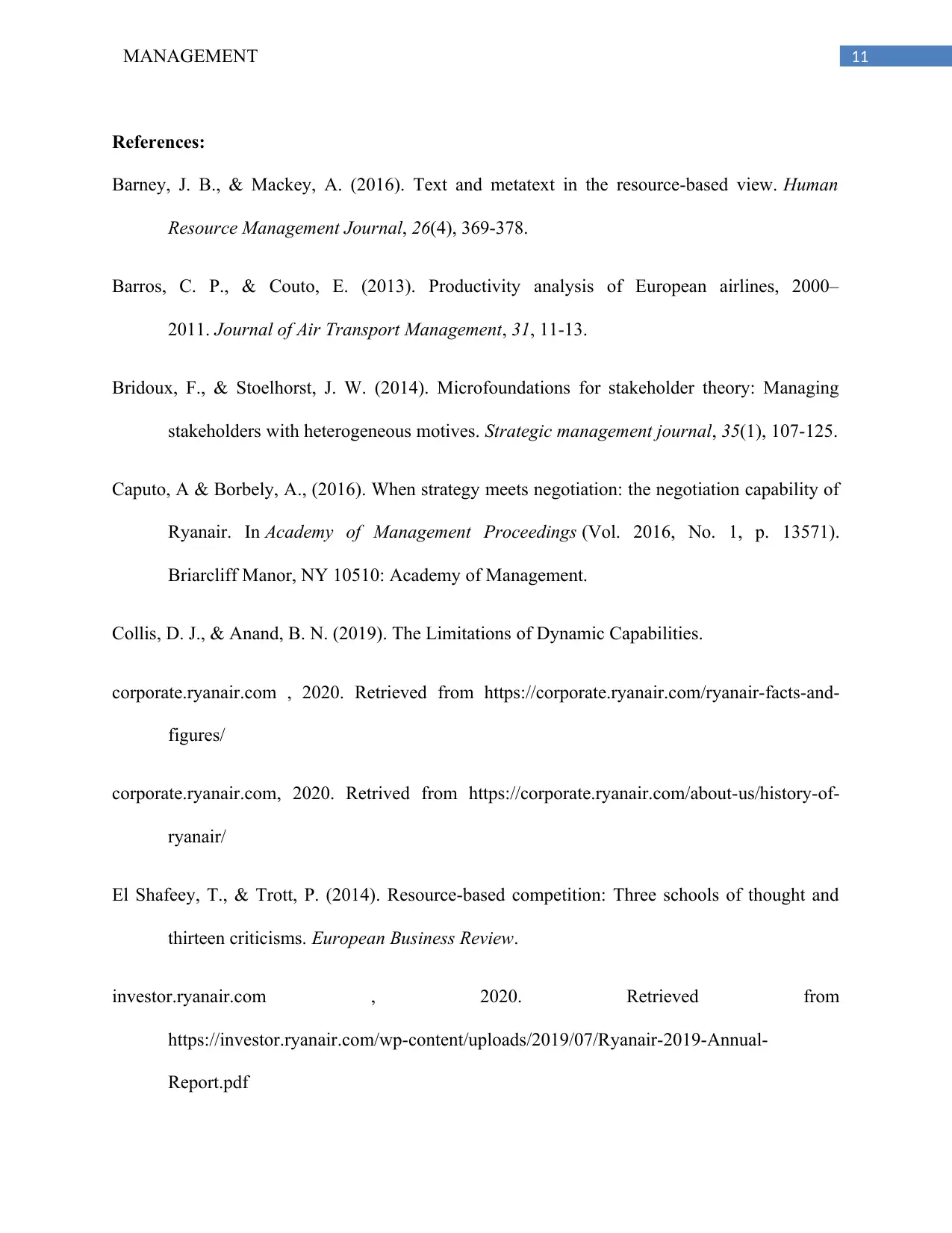
11MANAGEMENT
References:
Barney, J. B., & Mackey, A. (2016). Text and metatext in the resource‐based view. Human
Resource Management Journal, 26(4), 369-378.
Barros, C. P., & Couto, E. (2013). Productivity analysis of European airlines, 2000–
2011. Journal of Air Transport Management, 31, 11-13.
Bridoux, F., & Stoelhorst, J. W. (2014). Microfoundations for stakeholder theory: Managing
stakeholders with heterogeneous motives. Strategic management journal, 35(1), 107-125.
Caputo, A & Borbely, A., (2016). When strategy meets negotiation: the negotiation capability of
Ryanair. In Academy of Management Proceedings (Vol. 2016, No. 1, p. 13571).
Briarcliff Manor, NY 10510: Academy of Management.
Collis, D. J., & Anand, B. N. (2019). The Limitations of Dynamic Capabilities.
corporate.ryanair.com , 2020. Retrieved from https://corporate.ryanair.com/ryanair-facts-and-
figures/
corporate.ryanair.com, 2020. Retrived from https://corporate.ryanair.com/about-us/history-of-
ryanair/
El Shafeey, T., & Trott, P. (2014). Resource-based competition: Three schools of thought and
thirteen criticisms. European Business Review.
investor.ryanair.com , 2020. Retrieved from
https://investor.ryanair.com/wp-content/uploads/2019/07/Ryanair-2019-Annual-
Report.pdf
References:
Barney, J. B., & Mackey, A. (2016). Text and metatext in the resource‐based view. Human
Resource Management Journal, 26(4), 369-378.
Barros, C. P., & Couto, E. (2013). Productivity analysis of European airlines, 2000–
2011. Journal of Air Transport Management, 31, 11-13.
Bridoux, F., & Stoelhorst, J. W. (2014). Microfoundations for stakeholder theory: Managing
stakeholders with heterogeneous motives. Strategic management journal, 35(1), 107-125.
Caputo, A & Borbely, A., (2016). When strategy meets negotiation: the negotiation capability of
Ryanair. In Academy of Management Proceedings (Vol. 2016, No. 1, p. 13571).
Briarcliff Manor, NY 10510: Academy of Management.
Collis, D. J., & Anand, B. N. (2019). The Limitations of Dynamic Capabilities.
corporate.ryanair.com , 2020. Retrieved from https://corporate.ryanair.com/ryanair-facts-and-
figures/
corporate.ryanair.com, 2020. Retrived from https://corporate.ryanair.com/about-us/history-of-
ryanair/
El Shafeey, T., & Trott, P. (2014). Resource-based competition: Three schools of thought and
thirteen criticisms. European Business Review.
investor.ryanair.com , 2020. Retrieved from
https://investor.ryanair.com/wp-content/uploads/2019/07/Ryanair-2019-Annual-
Report.pdf
⊘ This is a preview!⊘
Do you want full access?
Subscribe today to unlock all pages.

Trusted by 1+ million students worldwide
1 out of 13
Related Documents
Your All-in-One AI-Powered Toolkit for Academic Success.
+13062052269
info@desklib.com
Available 24*7 on WhatsApp / Email
![[object Object]](/_next/static/media/star-bottom.7253800d.svg)
Unlock your academic potential
Copyright © 2020–2025 A2Z Services. All Rights Reserved. Developed and managed by ZUCOL.




